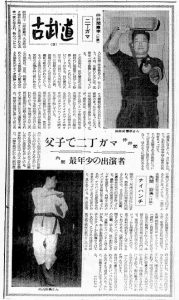Kobudō 9: Nakaima Kenkō and Uchima Anyū
November 26, 1961
Kobudo 9
Father-and-Son’s Nichō-gama
Nakaima Kenkō (51)
Nichō-gama
Born in 1910 in Kume, Naha into a family of martial artists referred to as the “Bō Nakaima,” Kenkō has been practicing karate for as long as he can remember. According to Kenkō, he had achieved a general mastery of his martial art by the time he was fourteen or fifteen years old.
His martial art is one mastered by his grandfather, Norisato (1), who studied it in Fujian China during the Qing dynasty. Kenkō shared an episode about this with us. Around the time his grandfather, Norisato, was fourteen or fifteen years old, a burglar entered his house on the night 10,000 cash coins in strings had been dropped off by a moai (2) support group. Thanks to the quick-witted response of a neighbor a bad outcome was avoided, but the incident made Norisato feel it was his obligation as a man to learn a martial art, and so he began training.
Around the time his martial art came to be known in Shuri and Naha, Norisato gave an exhibition of a tai (3) form at a party welcoming a ship of emissaries from China. His performance drew the attention of a Qing official and eventually lead to Norisato’s studies abroad.
Norisato trained for three years in Fujian before returning home. He never took any disciples, but instead passed the art down secretly from child to grandchild, keeping it within the Nakaima household. As a result, many aspects of the art were never made public, including its tai, kama, and bō weapons forms, as well as tenbe, shuchin, and more.
Mr. Nakaima has also mastered Okinawa’s unique equestrianism and it is said he is the island’s only school principal to own riding horses. “Military arts (4) were originally intended to kill people, but when the principles of morality are brought into play and the art is refined to the level of a philosophy, that is when it becomes a martial art (5),” he said, taking a small jab at the recent karate manslaughter incident at Takushoku University.
Regarding the kobujutsu that will be demonstrated, he noted that “we need to preserve the arts not simply because they are old, but because they have true value.” With that in mind, rather than picking one of the many newer alternatives, he chose to perform nicho gama and he’s eager to compare his techniques to those of other sickle users. Mr. Nakaima will be performing the kata Nicho-gama Nidan, and Ichidan will be performed by his second son, who is attending the University of the Ryūkyūs, making it a father-and-son performance.
Notes:
(1) Can also be read Kenri
(2) Moai are social groups formed in order for members to provide each other various types of support. Many Okinawans have monthly Moai gathering that last for decades with longtime friends, school mates, club members, etc.
(3) Written “Tai” in Hiragana in the text.
(4) Written Bujutsu in the text.
(5) Written Budō in the text.
The Youngest Performer
Uchima Anyū (23)
Naihanchi
Born in 1938 in the North Ward of Minamidaitō Island, Anyū is the only participating performer from a remote island. He arrived in Naha on the fourth, earlier this month, and is staying at the home of President Higa while waiting his turn to perform. Anyū, the youngest of the performers, will be demonstrating Naihanchi. While his Naihanchi differs from that of the main island, some suspect it has actually preserved the original Naihanchi form.
Anyū receives instruction from his uncle, Yasuichi, who studied karate in the South Sea Islands before the war while living under the same roof as Motobu Choyū’s son, Torajū (a nickname). Mr. Motobu was a disciple of Shuri’s Bushi Matsumura and Yasuichi received instruction from Choyū’s son, Torajū, which links Anyū to Bushi Matsumura’s lineage. When President Higa saw Anyū’s Naihanchi, he commented that “The eye positioning and movement of the hands, feet, and body are different from the Naihanchi of the main island. Since your uncle received instruction from Motobu Choyū’s son, Torajū, your upcoming demonstration may give us a glimpse of the original Bushi Matsumura form. Everyone will be watching your Naihanchi with great interest.” Karate has yet to catch on in Minamidaitō – the only practitioners there are Yasuichi, his son, and Anyū. Anyū began training at the age of fourteen and currently devotes any time not spent helping with farming to his karate practice.
“I’m really happy to be performing at the demonstration. I’ll get to see the kobudō of my seniors from the main island, and I also wanted to perform in front of everyone one more time,” he said, clearly looking forward to his performance.
Some more information on Uchima Anyū and the mentioned Naihanchi is available on the Motobu-ryū Blog and Motobu Chōmo alias Torajū.

